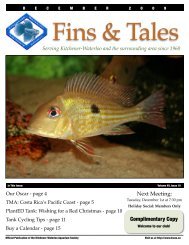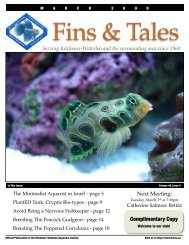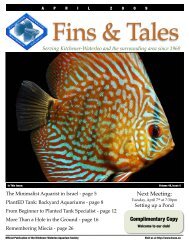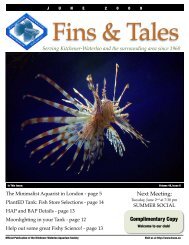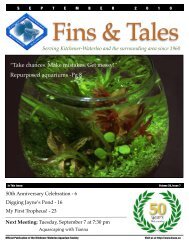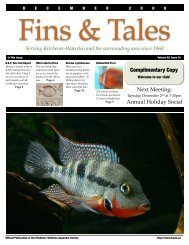October 2009 - Kitchener Waterloo Aquarium Society
October 2009 - Kitchener Waterloo Aquarium Society
October 2009 - Kitchener Waterloo Aquarium Society
Create successful ePaper yourself
Turn your PDF publications into a flip-book with our unique Google optimized e-Paper software.
O C T O B E R 2 0 0 9<br />
PlantED Tank: Pen is Mightier than Sword<br />
A Regular Column by Ed Koerner, KWAS (edkoerner@sympatico.ca).<br />
… But a good sharp knife is much better when dividing them…<br />
As most of you that have been reading my articles here have<br />
likely figured out by now, I am a bit partial to South American<br />
fish. I like plecos, corys, tetras, dwarf cichlids and many of the<br />
other cool and interesting SA species. With that, it would only<br />
be right to incorporate some plants from that bio type and I do<br />
have many in my collection.<br />
Maybe the most commonly thought of aquarium plant when<br />
thinking of the jungles and black water haunts of the Amazon<br />
would be – come on everyone and say it with me – the Amazon<br />
sword. I will describe some of the different swords that I have<br />
kept and propagated. They are quite easy to grow and<br />
propagate really and I did an earlier article on just that subject<br />
in the November 2008 issue of Fins & Tales. For any of you that<br />
do not have a copy Phil has set up a library of past issues on the<br />
KWAS website that can be accessed by club members. Check<br />
out some of those older issues for many interesting and useful<br />
articles and pearls of wisdom.<br />
Now back to our regularly scheduled program; Amazon<br />
swords. These plants fall into the family of Echinodorus and<br />
there are many different shapes, sizes, colours and leaf types to<br />
keep “planties” busy for some time. These babies can grow<br />
from small little pygmy chain swords two inches tall and<br />
thinner than grass to more substantial beast like Amazonicus<br />
that can grow well over two and a half feet tall. There are<br />
narrow leaves and wide leaves, green leaves and red leaves,<br />
straight leaves and ruffled leaves – in short there are currently<br />
30 different species catalogued in the CAOAC directory and<br />
there are more being found or developed all the time. I have<br />
found several new plants offered for sale just recently and hope<br />
to see the numbers grow steadily.<br />
Echinodorus are rather easy to grow and will adapt well to<br />
different water and tank conditions with very little serious<br />
needs. For light, they most need little more than 1 wpg but will<br />
handle higher levels without any issues. They may develop a<br />
bit of red in their leaves and there are several species that have<br />
been developed that are designed to show red. These will need<br />
more light to grow their best – put them in conditions that they<br />
will receive 1.5-2 wpg and their colours will be worth it.<br />
When fertilizing swords, they are more of a root feeder than<br />
leave feeder. Liquid fertilizers will still be useful and increase<br />
growth but you might want to try a tab or cone placed into the<br />
substrata at their roots. These will dissolve slowly over time<br />
and will provide nutrients for several months and can be<br />
simply placed and forgotten. It should be noted that swords<br />
have crowns above the root ball from which the leaves shoot.<br />
When planting be sure to bury the roots but not the crown as<br />
the plant will start to rot away if it is covered too deep. Also,<br />
when planting a large root ball, you may find it easier to either<br />
trim back some of the roots so that you can actually cover them<br />
without many sticking up out of the substrata and looking a<br />
mess or you can loosely tie the roots into a knot and bury the<br />
whole thing.<br />
Being from the Amazon, swords have evolved in soft and<br />
sometimes black water conditions. They will adapt to harder<br />
water but I feel that they will do best in softer water. Swords<br />
will often “melt” or loose most of their leaves when taken out of<br />
one tank and placed into another with widely different<br />
conditions. Usually the old leaves will brown and die back but<br />
if the root ball is healthy there will be new growth develop<br />
shortly. When leaves look to be dying or have been damaged it<br />
is better to trim off the whole leave from the plant. This will<br />
avoid the plant directing wasted attention to the damaged plant<br />
and concentrate its energies to producing new and acclimated<br />
leaves.<br />
Another issue that will often be seen is the leaves developing<br />
holes. This can be from a lack of nutrients and simple fertilizing<br />
should stop this from continuing and allowing new plants to<br />
grow with a rich and healthy appearance. Again, trim off any<br />
damaged leaves to help boost new growth.<br />
As mentioned, swords can acclimated to many conditions. They<br />
will even develop emersed growth and will grow leaves out of<br />
the water. I had a nice sized plant left floating for a while as I<br />
was making some changes to the tank and didn’t have room to<br />
put it anywhere. Well, it floated for some time and after a week<br />
I saw new growth from the root ball, as I had trimmed away<br />
most of the old leaves as they were damaged and rotting. The<br />
leaves were a bit thicker and red-tinged and were doing quite<br />
well for several weeks. Then, I decided to plant the thing and it<br />
only took a few days for the new leaves to fall apart and<br />
disintegrate. I am patiently waiting and hoping for yet another<br />
set of new leaves to form submerged, but starting to wonder if I<br />
waited too long to plant it.<br />
Temperatures do not seem to be a problem with most swords. I<br />
have seen them do fine in various temperatures from high 60’s<br />
in a pond to low 80’s in discus tanks.<br />
After plants have acclimated and have found a happy home<br />
they will grow and propagate in your aquarium. There are<br />
several methods that they will use, some being much easier to<br />
develop new plants from. As they grow and develop stronger<br />
root balls mother plants will send off runners that will send up<br />
plant shoots and will develop into individual plants. You can<br />
simply cut them form the mother plant and move them to<br />
10





